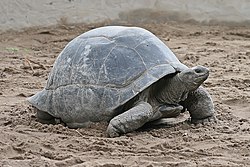| Aldabrachelys | |
|---|---|
 | |
| Scientific classification | |
| Kingdom: | Animalia |
| Phylum: | Chordata |
| Class: | Reptilia |
| Order: | Testudines |
| Suborder: | Cryptodira |
| Superfamily: | Testudinoidea |
| Family: | Testudinidae |
| Genus: | Aldabrachelys Loveridge & E. Williams, 1957 [1] |
| Species | |
| Synonyms | |
| |
Aldabrachelys [1] is genus of giant tortoises, including the Aldabra giant tortoise (Aldabrachelys gigantea) native to the Seychelles, as well as two recently extinct species, Aldabrachelys abrupta and Aldabrachelys grandidieri known from Madagascar. The genus name derives from Aldabra, a coral atoll in the Seychelles, plus Greek, chelys (χέλυς), for "tortoise" or "lyre", since Hermes was the first to invent the lyre from a hollowed out tortoise shell.
